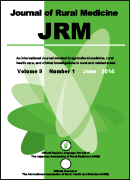Volume 9, Issue 2
Displaying 1-5 of 5 articles from this issue
- |<
- <
- 1
- >
- >|
Original articles
-
2014 Volume 9 Issue 2 Pages 51-58
Published: 2014
Released on J-STAGE: November 29, 2014
Advance online publication: June 17, 2014Download PDF (407K) -
2014 Volume 9 Issue 2 Pages 59-73
Published: 2014
Released on J-STAGE: November 29, 2014
Advance online publication: July 04, 2014Download PDF (2565K) -
2014 Volume 9 Issue 2 Pages 74-85
Published: 2014
Released on J-STAGE: November 29, 2014
Advance online publication: September 02, 2014Download PDF (770K) -
2014 Volume 9 Issue 2 Pages 86-89
Published: 2014
Released on J-STAGE: November 29, 2014
Advance online publication: October 19, 2014Download PDF (338K)
Case report
-
2014 Volume 9 Issue 2 Pages 90-92
Published: 2014
Released on J-STAGE: November 29, 2014
Advance online publication: October 06, 2014Download PDF (529K)
- |<
- <
- 1
- >
- >|
